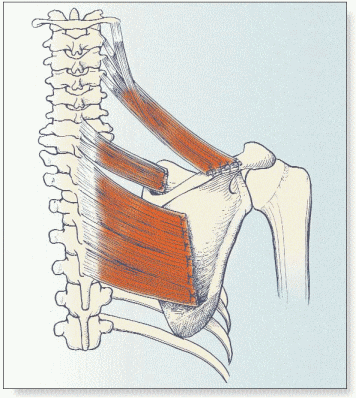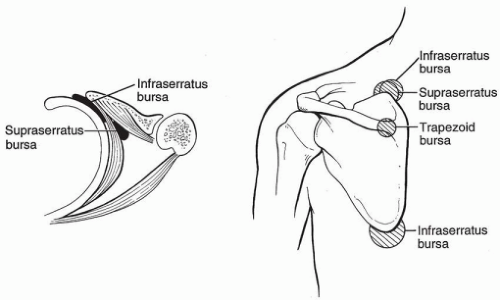The Painful, Snapping Scapula
Peter J. Millett
Philippe Clavert
Jon J. P. Warner
P. J. Millett, P. Clavert, and J. J. P. Warner: The Harvard Shoulder Service, Department of Orthopaedic Surgery, Massachusetts General and Brigham and Women’s Hospitals, Boston, Massachusetts.
INTRODUCTION
Periscapular pain is not uncommon and is often related to disease of the glenohumeral joint, subacromial bursa, and cervical or dorsal spine. The chest wall is convex, and normally the concave scapula and interposed muscles glide smoothly along this wall. The inferior and superior angles of the scapula are not well cushioned. Even if bony anomalies of this region are rare,5,6,28,30,33 they may be responsible for inflammation of the surrounding bursa. Although conservative management usually alleviates symptoms, surgical treatment can be performed in the case of refractor pain. Usually this includes an open or arthroscopic resection of the superomedial scapular angle, with a scapulothoracic bursectomy.
HISTORICAL PERSPECTIVE
Symptomatic scapulothoracic bursitis and crepitus are difficult and often poorly understood disorders of the scapulothoracic articulation. Little has been written about arthroscopic or open solutions for refractory pain from this region. The first step20 is to realize the subtle differences between these two related entities. Historically, several terms have been used to describe various elements of the clinical spectrum, including the snapping scapula,4,27 scapulothoracic syndrome,29 washboard syndrome,9 and rolling scapula.10 Boinet4 is generally credited with the first description of scapulothoracic crepitus in 1867, and Mauclaire22 later described three subclasses: froissement, frottement, and craquement in 1904. Froissement is a gentle physiologic friction sound, frottement is a louder grating sound and is usually pathologic, and craquement is a consistently pathologic loud snapping sound. Milch27 added to the understanding in 1961 by differentiating scapulothoracic crepitus into a loud, usually painful grating sound caused by a bony lesion and a less intense sound caused by a soft-tissue lesion such as bursitis. Kuhn et al.20 extrapolated from Milch, proposing that frottement may represent a soft-tissue lesion or bursitis, whereas craquement represents an osseous lesion as the source of the painful scapulothoracic crepitus. Precise distinction may be difficult even radiographically or surgically. Furthermore, it is crucial to understand that clinically symptomatic bursitis may exist without an audible sound or palpable crepitus. Moreover, isolated crepitus in the absence of pain may be physiologic.
The timing and choice of intervention are influenced by the severity and cause of the symptoms, and an understanding of these two entities will assist the clinician in appropriate diagnosis and treatment.
ANATOMY AND BIOMECHANICS
The anatomy and biomechanics of the scapulothoracic articulation are important to understand when treating these problems. Two major and four minor, or adventitial, bursae have been described in the scapulothoracic articulation (Fig. 30-1).9,17,18,20,35,36,41 The first major bursa, the infraserratus bursa, is located between the serratus anterior muscle and the chest wall. The second, the supraserratus
bursa, is found between the subscapularis and the serratus anterior muscles (Fig. 30-1). The anatomic consistency of these bursae is well documented.9,17,18,35,36,41 In addition, four minor bursae have been identified.20,35,41 These, however, have not been consistently found in cadaveric or clinical studies. These bursae have been postulated to be adventitial in nature, arising in response to abnormal biomechanics of the scapulothoracic articulation.20,35,41 Two have been described at the superomedial angle of the scapula, and historical accounts identify the location to be either infraserratus or supraserratus. A third site of pathology is at the inferior angle of the scapula, thought to be an infraserratus bursa. The fourth location, the trapezoid bursa,11 is at the medial base of the spine of the scapula, underlying the trapezius muscle. It is usually the bursa in the region of the superior angle of the scapula that is symptomatic20,35 (Fig. 30-1).
bursa, is found between the subscapularis and the serratus anterior muscles (Fig. 30-1). The anatomic consistency of these bursae is well documented.9,17,18,35,36,41 In addition, four minor bursae have been identified.20,35,41 These, however, have not been consistently found in cadaveric or clinical studies. These bursae have been postulated to be adventitial in nature, arising in response to abnormal biomechanics of the scapulothoracic articulation.20,35,41 Two have been described at the superomedial angle of the scapula, and historical accounts identify the location to be either infraserratus or supraserratus. A third site of pathology is at the inferior angle of the scapula, thought to be an infraserratus bursa. The fourth location, the trapezoid bursa,11 is at the medial base of the spine of the scapula, underlying the trapezius muscle. It is usually the bursa in the region of the superior angle of the scapula that is symptomatic20,35 (Fig. 30-1).
The chest wall is convex and cushioned by several muscles, but especially by the serratus anterior. The concave scapula and interposed muscles glide smoothly along this wall. It is inferred that this condition results from incongruence of the scapulothoracic articulation, which may or may not be associated with bony anomalies of this region.5,6,28,30,33 Because bony abnormalities are rare, a dynamic compression or maltracking14,40 is postulated to be responsible for the pathologic contact between the superior angle of the scapula and the ribs that compresses and irritates the bursa between these two structures.20,41,42 Clinical studies and histologic findings of bursitis, muscle intrafascicular fibrosis, shoulder girdle muscle atrophy, and edema support this hypothesis.20,33 Rarely, bony abnormalities such as osteochondromas or Luschka’s tubercles may be the cause of the crepitus.
The scapular noises encountered in crepitus arise from anatomic changes of the soft tissues in the articulation or from bony incongruity because of the anatomic anomalies of the bones themselves.
DIAGNOSIS
Clinical Evaluation
Clinical evaluation of scapulothoracic bursitis and crepitus begins with a thorough history and physical examination. The history of the problem is similar in both disorders. Patients with bursitis report pain with overhead activity,36 often with a history of trauma or repetitive overuse in work or recreation.1,5,20,23,24,36 This constant motion irritates the soft tissues, leading to inflammation and a cycle of chronic bursitis and scarring. This tough, fibrotic bursal tissue can then lead to mechanical impingement and pain with motion, and thus further inflammation. Audible or palpable crepitus may accompany the bursitis. Patients with scapulothoracic crepitus may additionally report a family history, and it is occasionally bilateral.10
The physical findings of bursitis include a localized tenderness over the inflamed area. The superomedial border of the scapula is the most common location, but the inferior pole is also a site of pathology. A mild fullness can be palpated, and audible or palpable crepitus may be present. Physical findings in patients with crepitus include point tenderness as well, whereas visual inspection may also reveal a fullness or a compensatory pseudo-winging of the scapula as the individual attempts to avoid the painful bursitis. A mass may be palpable. The scapula will grate as the shoulder is put through a range of motion. In those with winging, it is crucial to perform a careful neuromuscular examination to differentiate compensatory pseudo-winging from true winging. Although some patients may exhibit winging, this may be secondary
to pain from the scapulothoracic articulation, and motor examination of the serratus anterior and trapezius will demonstrate normal function of these muscles. If the issue remains unclear, an electromyogram and nerve conduction study may be helpful. Again, crepitus alone in the absence of pain can be physiologic and rarely warrants treatment.
to pain from the scapulothoracic articulation, and motor examination of the serratus anterior and trapezius will demonstrate normal function of these muscles. If the issue remains unclear, an electromyogram and nerve conduction study may be helpful. Again, crepitus alone in the absence of pain can be physiologic and rarely warrants treatment.
Positive Diagnosis
Selective injections with a corticosteroid and local anesthetic may be very helpful to confirm the diagnosis (Fig. 30-2). The injection can be diagnostic and therapeutic,5,10,23,33 because immediate symptomatic relief after injection of the local anesthetic helps to confirm the cause of pain and the anatomic location of the bursa in question. If this injection is accurately placed into the scapulothoracic bursa and the patient notes significant pain relief, it confirms the diagnosis.23,33 The steroid may also afford an anti-inflammatory effect that facilitates a physical therapy program as noted next. The injection should be placed with some caution to avoid a pneumothorax.5
Stay updated, free articles. Join our Telegram channel

Full access? Get Clinical Tree










